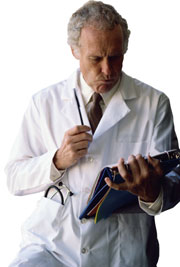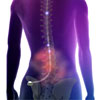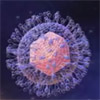- What is Pain after shingles (Postherpetic Neuralgia (PHN))?
- Statistics
- Risk Factors
- Progression
- Symptoms
- Clinical Examination
- How is it Diagnosed
- Prognosis
- Treatment
- References
What is Pain after shingles (Postherpetic Neuralgia (PHN))?
Postherpetic neuralgia (PHN) is a condition where enduring pain continues after a case of shingles (herpes zoster (HZ)) has cleared up. PHN occurs once the HZ rash has healed and there is no inflammation remaining at the site of infection.
Herpes zoster (HZ) is an inflammatory condition that is caused by the activation of a virus that has been lying dormant in the body. Varicella-zoster is the same virus that causes chicken pox, therefore HZ only occurs in people who have had chicken pox. Once a person has had chicken pox the virus remains in nerve cells near the spine. Chicken pox will never reoccur if the virus is “reactivated”, instead a condition far worse than chicken pox develops- HZ.
HZ is an inflammatory condition characterised by a blistering, itching and burning rash that eventually heals. For some people the pain does not go away once the rash has healed and this is PHN. This pain experienced in PHN is neuropathic pain which is very difficult to treat.
 |
For more information, see Herpes Zoster (HZ). |
The neuropathic pain involved in PHN is thought to be caused by abnormal pain signals in the nervous system that occur as a result of the damage caused by the virus. These abnormal firing signals are thought to be related to one or more of:
- De-afferentation: If the damage from inflammation from the HZ is severe enough then it can result in de-afferentation of the nerves. This is the disruption of the impulses that are carried by the nerves.
- Sensitisation: The constant pain signalling that occurs during HZ hypersensitises the nerves which make them overly responsive to pain.
- Abnormal pain interpretation: The damage to the nerves has the potential to cause the brain to interpret pain signals incorrectly. The person will then experience pain when there is no longer an external contributor, like inflammation.
PHN can be a highly distressing and debilitating condition that can negatively affect a person’s physical, emotional and social wellbeing.
Statistics

From 2000-2006 it has been estimated that 10 out of 1,000 Australians over 50 years of age contracted HZ. For PHN the incidence was 1.45 people in 1,000.
Anyone that contracted chicken pox at any stage of their life is at risk of developing HZ and therefore PHN. The reactivation of the virus most commonly occurs in people that have a decreased immunity. This includes:
- The elderly;
- People with diseases that affect the immune system, like HIV; or
- People with diseases that require treatment which has an effect on the immune system, such as treatment with chemotherapy for cancer.
People at risk need to be closely monitored so that if HZ occurs, their doctor can immediately intervene. People that are not actively reminded of the risk of HZ are more likely to be diagnosed late and so the risk of developing PHN is greater.
Risk Factors
The major predisposing factor to PHN is chicken pox followed, sometimes decades later, by HZ. Not all people that experience HZ will be affected by PHN. In fact, the figures vary between 9 and 34%.
Although there is no definite way to determine which people will develop PHN there are some probable indicators:
- Those who experience more severe pain during the early stages of HZ are more likely to experience PHN;
- The level of inflammation (the pain is often related to the level of inflammation during this stage which is therefore also a predisposing factor); and
- The older a person is when they develop HZ, the greater the risk they will develop PHN. For patients younger than 50 the risk is very low, however for patients over 80 the risk is around 34%.
Clinical Examination
Commonly, people with PHN will experience a degree of sensory loss in the area innervated by the affected spinal segment. The response to a pinprick, heat changes and vibrations in that area will be less sensitive than surrounding unaffected areas but this will induce significantly more pain. It is suggested that this area is where spontaneous pain is experienced whereas the surrounding areas less affected by the virus will be the areas responsible for the feeling of allodynia. There is more likely to be a pain response to cold than to heat.
How is it Diagnosed
As PHN is solely the persistence of pain after HZ has cleared up there are usually no visible features to aid in diagnosis however some people will have some scarring and pigmentation from the rash.
PHN is not diagnosed until 2-3 months after the shingles rash has healed. If similar but refractory pain persists at this point, then the individual has more than likely developed PHN. The rash, and therefore the pain, will most commonly manifest in the torso and can include any of the following feelings of pain at differing degrees:
- Lancinating pain: this term is used to describe all types of what we experience as ‘sharp’ pains this includes jabbing, piercing, knife-like, cutting of stabbing;
- Allodynia: an abnormal, unpleasant and painful sensation that can occur in the area where the rash was or in the surrounding area;
- Burning pain;
- Aching pain;
- Spontaneous pain; and
- Hyperalgesia: this is the increased sensitivity to pain.
For some, it may be only one of the above pain while for others it will be a combination (such as background aching with spontaneous pain spikes throughout the day). In some cases the pain is avoidable if certain situations that may exacerbate the pain can be steered clear of such as wearing tight-fitting clothing or exposure to sudden and intense changes in temperature. Unfortunately though even very light pressure, such as a gentle breeze or a brush of clothing, can cause some people intense pain, and this is for the most part unavoidable.
Continuing, severe pain can have a major affect on quality of life. Commonly experienced side effects stemming from chronic pain include:
- Loss of sleep and the consequences associated with fatigue;
- Depression:
- Loss of enthusiasm, motivation and sex drive ;
- Negative impact on relationships and social life; and
- Feelings of isolation, fear and anxiety can also occur.
Prognosis

Luckily for many people,PHN will go away within a year. However, for approximately 40% of PHN sufferers the pain continues long-term.
Treatment
PHN is a very difficult condition to treat effectively. A large number of people who have contracted PHN will be refractory (not respond) to most medications and procedures that are currently used to treat the condition.
Prevention
The best treatment for PHN is prevention. In order to have the best chance of preventing PHN patients and their doctors must act early once the HZ has presented itself. The best therapy option is treatment with anti-viral agents such as famicilovir or valacicovir. This is sometimes very difficult as many patients, and even some doctors, may not know how to recognise the condition as shingles in the early stages. However, in order for antiviral therapy to be effective it must be administrated in the first 48 hours, at the latest 72 hours, from rash onset. That said, some people that begin the anti-viral treatment very early will still develop PHN.
Epidural administration of steroids and analgesics at the level of inflammation has also been found to be effective in reducing PHN occurrence. The steroids are thought to protect the neurons and the analgesics stop the continuous stimulation of pain.
Tricyclic antidepressants (TCAs)
At daily doses of around 10-25mg TCAs have been found to be a promising strategy to treat over 50 % of the pain in PHN and have also been found to be moderately effective in prevention if used early once the rash has presented.
Antiepileptic medications
Antiepileptic medications such as carbamazepine, phenytoin [phenytoin], gabapentin and pregabalin have been proven to be efficacious in treating PHN pain, aiding in ability to sleep and improving quality of life. The drawbacks of antiepileptic medication are the heavy side effects such as headache, dizziness and sleepiness, which are especially disconcerting in the elderly.
Perhaps the best studied are gabapentin and pregabalin which are thought to act specifically in the spinal cord.
Topical treatments
The US and UK have approved lidocaine 5% patches in the treatment of PHN. The patch is placed somewhere comfortable on the torso, not where the pain is experienced or somewhere that is likely to be disrupted through daily routine. The patch slowly releases the local anaesthetic throughout the week to help numb the pain. The patch needs to be replaced regularly.
Axsain is a topical capsaicin which is indicated in the treatment of PHN. The cream should be applied to the affected area. The treatment works to relieve pain from nerves near to the surface of the skin.
Spinal cord stimulation
If all other options have not been successful, spinal cord stimulation (SCS) has recently been used for treating PHN. It has not yet been extensively studied, but results to date have shown that up to 82% of people received pain relief after experiencing pain from PHN for up to 2 years.
 |
For more information, see Spinal Cord Stimulation and Spinal Cord Stimulation Devices. |
Lifestyle and psychology
A lifestyle change can make a big difference to treatment success and managing pain in PHN. Lifestyle changes that may help people with PHN include:
- Avoiding activities, situations and clothing that exacerbate the pain;
- Learning how to manage the condition and how to cope with the pain and side effects of the treatment;
- Improving positive outlook by adopting a healthier lifestyle, which also benefits physical and psychological profile; and
- Modifying thinking patterns in order to reduce stress and anxiety through help with psychotherapy programs such as cognitive behavioural therapy.
More information
 |
For more information on chicken pox, shingles and postherpetic neuralgia, as well as some useful videos, see Chicken pox, shingles and postherpetic neuralgia. |
References
- Hawksley, H. Managing pain after shingles: a nursing perspective. Brit J Nurse. 2006; 15(15): 814-8. [Abstract]
- Pearce, JS. Post herpetic neuralgia. J Neurol Neurosurg Psychiatry. 2005; 76: 572. [Full text]
- Rang HP, Dale MM, Ritter JM, Moore PK. Pharmacology (5th edition). London: Elsevier Science; 2003. [Publisher]
- Rowbotham MC. Mechanisms of neuropathic pain and their implications for the design of clinical trials. Neurol. 2005; 65(12 Suppl 4) S66-73. [Abstract]
- Hardy D. Relief of pain in acute herpes zoster by nerve blocks and possible prevention of post-herpetic neuralgia. Can J Anaesth. 2005; 52(2): 186-90. [Abstract]
- Naja ZM, Maaliki H, Al-Tannir AA, El-Rajab M, Ziade F, Zeidan A. Repetitive paravertebral nerve block using a catheter technique for pain relief in post-herpetic neuralgia. Brit J Anaesth. 2006; 96 (3): 381-3. [Abstract | Full text]
- Opstelten, W. Design issues for studies into prevention of chronic pain: lessons from post-herpetic neuralgia. Anaethesia. 2004; 59: 211-5.
- Stein AN, Britt H, Harrison C et al. Herpes zoster burden of illness and health care resource utilisation in the Australian population aged 50 years and older. Vaccine. 2009; 27(4): 520-9. [Abstract]
- Gebo KA, Kalyani R, Moore RD, Polydefkis MJ. The incidence of, risk factors for and sequale of herpes zoster among HIV patients in the highly active antiretroviral era. J Aquir Immune Defic Syndr. 2005; 40(2): 169-74. [Abstract | Full text]
- Nurmikko T (1995). Clinical features and pathophysiologic mechanisms of postherpetic neuralgia. Neurology. 45(12 Suppl 8):S54-5. [Abstract]
- Robb-Nicholson C. Does post-herpetic neuralgia raise C-reactive protein? [online]. Harvard Women’s Health Watch. 2006: p8. [cited Jul 2009] Available from: URL link
- Lui HT, Tsai SK, Kao MC, Hu JS. Botulinum toxin a relieved neuropathic pain in a case of post-herpetic neuralgia. Pain Medicine. 2006; 7(1): 89-91. [Abstract]
- Harke H, Gretenkort P, Ladleif HU, Koester P, Rahman S. Spinal cord stimulation in postherpetic neuralgia and in acute herpes zoster pain. Anesth Analg. 2002; 94: 694 -700. [Abstract | Full text]
All content and media on the HealthEngine Blog is created and published online for informational purposes only. It is not intended to be a substitute for professional medical advice and should not be relied on as health or personal advice. Always seek the guidance of your doctor or other qualified health professional with any questions you may have regarding your health or a medical condition. Never disregard the advice of a medical professional, or delay in seeking it because of something you have read on this Website. If you think you may have a medical emergency, call your doctor, go to the nearest hospital emergency department, or call the emergency services immediately.







